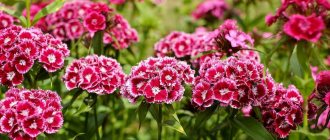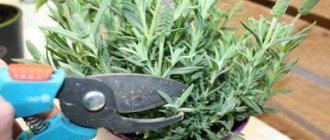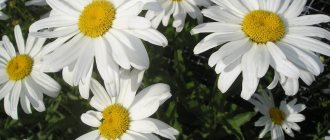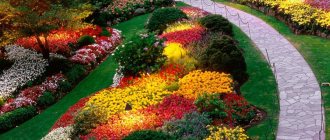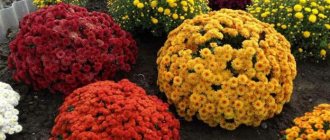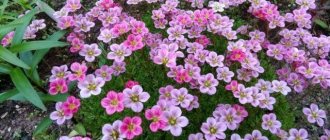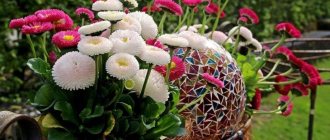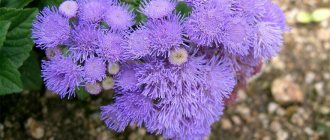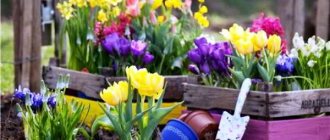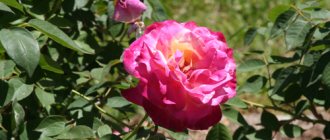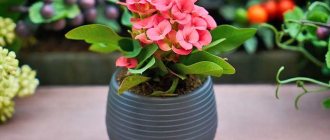A little history and mysticism
The aster plant was known to the inhabitants of ancient Rome and Greece. In those distant times, charming buds decorated houses and temples; the flower itself was considered a reliable amulet against evil forces and was dedicated to Aphrodite, the goddess of love, unfading beauty and fertility.
Some legends attribute the origin of flowers to the goddess Persephone, who was imprisoned with her unloved husband in the farthest dungeons of the Kingdom of the Dead and could only sometimes rise to the surface of the earth. The tears of the goddess of spring, who saw the couple in love, turned into light stars, and later flowers with radiant petals grew at the site of their fall.
Chinese legends associate the appearance of the flower with monks who decided to reach the sky in order to take a closer look at the stars that litter the sky. When they failed, they found a charming clearing that greeted them with gentle rays of unusual flowers. Taking them as a sign from above, the clergy dug up several bushes and took them to their native monastery so that everyone could enjoy the lovely view of the earth’s stars.
China acquired the right to be called the homeland of asters, and in modern Europe, the solemn ascension of flowers to the podium began in the 17th century, where they were brought by French monks traveling around the world.
The largest range of unpretentious flowers is located in Central and North America, and numerous representatives of this family can be found everywhere.
Asters are still considered symbols of beauty and light charm, sophistication and grace to this day. They give special benefits to people born under the sign of Virgo, helping them overcome all life’s troubles, bringing love and good luck.
Europeans, on the contrary, consider asters to be a flower of sadness and sadness.
This many-sided aster: varieties
The perennial aster plays with bright colors, giving the autumn flower garden a special charm and attractiveness. It's like a farewell greeting from summer before a long, cold winter. Bush forms are varied: there are low-growing and tall varieties from 35 to 150 cm.
Regardless of height, the bush is powerful, spherical in shape, and capable of growing quickly. A plant with lanceolate leaves at the top is strewn with flowers with an inflorescence-basket from 2 to 8 cm in diameter. They form simple and terry shapes. The colors are distinguished by an enviable variety: from white to bright red and blue, and in different shades.
Garden varieties of asters are divided according to a number of characteristics. Let's consider species popular among gardeners with different flowering periods:
- Alpine aster is light-loving and frost-resistant. Forms large single baskets 6-8 cm in diameter. Flowering begins in the second year. Flowering dates are early: late May - mid-June.
- New Belgian aster (Virginian) is a native of North America. Interesting with flowers of blue and burgundy shades. Large flowers remain open in the evening and in cloudy weather. If the place is sunny, flowering continues until frost. Despite its large size, it looks great in flower beds. It can be placed in the center, and low-growing crops can be planted along the edge as a frame. Corymbose inflorescences form beautiful bouquets that can be combined with dahlias, herbs and autumn leaves.
- Star aster is a summer flowering plant.
- A popular variety, the Italian aster is a medium-height shrub with medium-sized flowers of a wide variety of colors. Flowering begins in July and continues until the end of August.
- The bush aster is a creeping variety that ranges in size from dwarf to tall. Does well in cool, sunny areas, but does not like drought and heat. Grows in one place for up to 6 years.
- The New England aster is large in size (up to 150 cm). The flowers are double and numerous. The whole plant is strewn with them and stands out against the green background like a bright sunspot. The colors are varied: red, pink, purple and dark blue. Thanks to this, it is easy to create a unique flower arrangement.
- In the last month of summer, the golden aster will delight you with its yellow flowers. The inflorescences have a pineal shape and are located on strong shoots.
- The side-flowering aster is distinguished by the shape of its shoots, reminiscent of a grapevine. Small inflorescences are white or slightly pink at first, and become purple towards the end of flowering.
- Heather aster is a meter-long compact bush. Small inflorescences open at the end of September.
Low-growing asters are used for rock gardens or borders.
If you plant them on the lawn, you get an interesting composition of “flower balls”. They go well with cereals or low conifers.
Tall varieties are perfect for creating the background of a composition, forming a garden screen of bright “stars”.
The lower tier can be low-growing perennials: autumn helenium, Korean chrysanthemum, thick-leaved bergenia or Siebold's host.
The perennial aster, the varieties of which are so diverse, provides an opportunity to get creative and create a beautiful flower design that will decorate your site and arouse the admiration of surrounding summer residents. Read about: perennial gaillardia - planting and care
Description of the plant
The plant has a straight stem, on the flat surface of which there are small fluffy hairs and carved leaves. The buds appear on the side stems and are small baskets tightly wrapped in lush green leaves.
The baskets themselves may have one or several rows of fluffy petals, but the more rows there are, the prettier and more magnificent the bud looks.
The height of the plant ranges from 15 centimeters to almost a meter, which makes it possible to use them as the main decoration of a flower bed or its edging, plant noble flowers in a picturesque group or individually, and decorate them with other plants.
Cut buds retain their charming appearance for a long time, which makes them the favorite flowers of many housewives.
Various types and varieties of unpretentious plants will help you decorate your garden in the most unusual way, filling the ground with all the colors of the rainbow, as is clearly shown by all sorts of photos of asters.
Description of the perennial flower Astra
Thanks to the pointed shape of the petals, collected in a lush inflorescence, asters are associated with celestial stars. Many poets and writers sang its beauty in their works, and in ancient times the aster was endowed with mystical, symbolic qualities.
Photos of Aster flowers
Aster is a rhizomatous crop with simple dark green leaves located on an upright growing stem. The inflorescence of a flower is a basket collected from oblong, pointed petals. The color range of flowers is varied: snow-white, pink, bright red, purple, violet, yellow. Thanks to selection, the color spectrum of asters is constantly expanding. The varietal diversity includes annual and perennial specimens.
Selecting a location
Planting an aster and its future life begins with determining the most suitable place of residence for the plants. Such a place will be an area well illuminated by the sun's rays, or a small partial shade with loose soil.
The seedlings will feel great in the place where marigolds or calendula grew, but will not be very accepting of the territory that in the past was given over to gladioli, tulips, potatoes or tomatoes.
Landing
Planting and caring for aster in open ground is not difficult and is accessible even to novice gardeners.
Seedling method
Plant cultivation begins in early spring (mid-March), when aster seeds are sent into the ground for germination indoors. The seeds germinate quite quickly without additional movements from the hostess, so the first shoots can appear already 3-4 days after planting.
As the plants grow, they are hardened off. Transplantation to a permanent place is carried out in late April-early May.
Seeds
Unpretentious flowers can also be grown by planting seeds in open ground, but this is done after the temperature does not steadily drop below 10 degrees. In this case, the seeds are placed in furrows, lightly sprinkled with soil and covered with mulch.
When sprouts appear, the protective layer of grass and leaves is removed. But it should be taken into account that bushes grown in this way will bloom a couple of weeks later than plants obtained by seedlings.
Planting in the ground can also be done in late autumn. In this case, the seeds are placed in frozen ground in pre-prepared grooves and sprinkled with soil. Sprouts that hatch in the spring have a much higher endurance threshold.
Flowering will begin 90-110 days after sowing, depending on the variety.
Care
Asters will not require much time and effort to care for. Adult bushes are not afraid of lower temperatures, but prefer warmth from 18 to 25 degrees.
You should not get too carried away with watering plants, this can lead to plant diseases, so on heavy soils the solution to the question of how to water asters is carried out with the help of high-quality drainage. Asters do not like spraying, which significantly saves housewives’ energy. But the soil should not be allowed to dry out.
Mineral fertilizers or well-diluted chicken manure are used to feed the plant. But its use is recommended on really poor soils. The first application of fertilizer is carried out several weeks after transplantation to a permanent place, the second and third are timed to coincide with the appearance of buds and their flowering.
Loosening and weeding will help provide the aster with more oxygen and nutrients. To prevent the soil from becoming crusty, the soil is loosened after each watering or rain. Weed removal is done as needed.
Diseases and pests of garden Aster
The most common disease affecting flowering perennials is Verticillium wilt . This can be determined by the following symptoms.
- the leaves suddenly hang limply, dry out and finally die - no matter how much the plant is watered;
- stems turn brown;
- Reddish mucus appears on the plant.
The disease is caused by the fungus Verticillium, which blocks the plant and prevents moisture from passing through the flower tissue. Infected bushes can no longer be saved; they need to be dug up and thrown away as quickly as possible. Since perennial fungi have taken root in the soil, a diseased plant cannot be composted. After the Astra has been removed, the soil should be mixed with calcium nitrogen. Only eight years later, Asters can be planted again in the affected area. Since fungi only attack these flowers, other plants can be used here.
To prevent Verticillium wilt of Aster, you can use the following measures:
- plant flowers in sterile soil;
- change the location of plants every few years;
- divide each plant every three to four years;
- use disease-resistant varieties.
Also worth mentioning is Fusarium . Your flowers are also susceptible to this disease. The symptoms of the disease are the same as Verticillium fungus infection. There are no methods to combat this vomiting yet. Here it is also worth carrying out the prevention described above.
Seedlings of these plants can become infected with blackleg. The root collar begins to darken and later rot. Unfortunately, the seedlings cannot be saved.
Powdery mildew . A plant that is rarely cared for often becomes infected with this pest. The main reason is constant waterlogging. The disease manifests itself with various symptoms.
- small white or gray spots on the top of the leaf;
- the spots form a powdery coating that covers the leaves, shoots, flowers and buds;
- the affected parts of the plant turn brown and fall off;
- the plant is getting shorter and shorter.
Aster can be saved if the infection is detected in time. All affected parts of the plant must be cut off and discarded. Subsequently, the plant should be thoroughly sprayed with a fungicide that acts against mold.
The following preventive measures reduce the risk of infection:
- plants should be watered close to the ground, and not from above, so that the leaves do not get wet;
- those who plant several Asters should not plant them too close to each other, as a result, individual plants are better ventilated, and precipitation and water from a watering can or hose will dry out faster;
- Asters should not be fertilized too much.
Pests
Basically, Asters are more affected by diseases, less often by pests. The most common parasite that can be found on a flower is usually aphids. Wash off small insects with soapy water. The affected plant should be sprayed several times at intervals of two to three days from all sides. Once the aphids are no longer visible, the treatment can be completed.
Care after flowering
Annual plants (and most of them) are dug up and burned, perennial bushes are left in place or moved to a new site. The planting site must be changed at least once every five years.
It is not necessary to cover the plant for the winter; asters have fairly good resistance to frost.
Unpretentious, colorful, familiar and unusual asters can easily and quickly decorate your garden and cottage, filling flower beds and borders.
Use in landscape design, examples
Perennial asters will be an excellent plant for the background of a flower garden. Tall varieties of the crop can be used to create hedges. Small plants should be used to decorate garden paths and borders. Also, dwarf varieties are suitable for growing in rock gardens, rock gardens, and in the foreground of flower beds.
It is better to plant perennial asters next to carnations, peonies, lilies and roses. But they are not suitable for proximity to garden crops (potatoes, tomatoes) and conifers, because of which the flowers begin to hurt.

